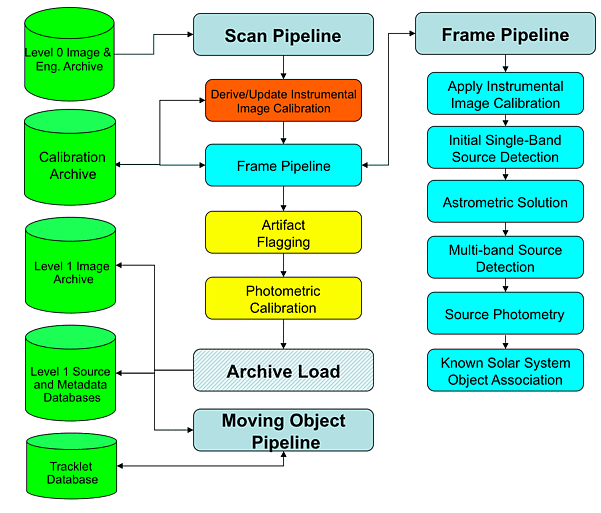


IV. WISE Data Processing
3. Pipelines
a. The Scan/Frame Pipeline
The WSDS Scan/Frame pipeline operates on individual single-exposure
framesets within one or more WISE
scans.
Level 0 images and metadata
that are generated by the Ingest procedure
are used as input. Scan/frame processing performs basic
instrumental calibration, detects and characterizes sources from individual
images, derives and applies astrometric and photometric calibrations,
and flags sources that are positionally associated with the expected
location of image artifacts. The Scan/Frame Pipeline also determines
if any known solar system objects such as asteroids, comets,
planets and planetary satellites were within the field-of-view of the
single-exposure framesets.
The elements of the Scan/Frame pipeline processing flow are shown
in Figure 1. For each scan processed, repeated calls
to the Frame pipeline are made that perform frame image calibration,
source detection and extraction, astrometric solutions and the
frame level of artifact identification. Scan/frame processing includes
a final step in which time-ordered artifact identification and photometric
calibration information is derived from a sequence of scans, and then
applied to the individual single-exposure images and source lists.
The Scan/Frame processing steps are:
- Instrumental Image Calibration - Instrumental
signatures are removed from the individual Level 0 images data
in the ICAL subsystem (IV.4.a).
ICAL performs "droop" corrections, dark-subtraction, non-linearity correction,
flat-fielding, and dynamic sky-offset subtraction and transient
pixel flagging.
- Multiband Source Detection - Sources are detected simultaneously in
the four WISE bands on a signal-to-noise image formed from the calibrated
four-band single-exposure images in the MDET source detection step
(IV.4.b)
- Source Extraction - Positions and photometry for detected sources
are measured on the calibrated, single-exposure image in the WPHOT subsystem
(IV.4.c). Profile-fit photometry is performed
simultaneously in four bands, along with a variety of aperture photometry
measurements.
- Astrometric Calibration - An astrometric transformation is derived
for each individual single-exposure frameset by the SFPREX
subsystem (IV.4.d). WISE source
extractions are matched to astrometric reference stars derived from the
2MASS Point Source Catalog to solve for the conversion between frameset
pixel and equatorial coordinates. The astrometric solution parameters
are used to refine the WCS keywords in the Single-exposure image headers, and
to report equatorial positions for entries in the Single-exposure source
database.
- Known Solar System Object Association - The SSOID subsystem
(IV.4.e) determines if any asteroid, comet, planet,
or planetary satellite, with an orbit known at the time of data processing,
may have been within the field of view of each individual WISE
single-exposure at the time of the WISE observation. SSOID outputs the
list of objects predicted to be in each single-exposure field-of-view.
If a single-exposure source detection is near the predicted position of a
solar system object, SSOID also outputs the information for the associated
WISE source.
- Artifact Identification - The ARTID subsystem (IV.4.g.) identifies single-exposure source extractions that are
positionally associated with the predicted positions of image artifacts
produced by bright sources, including latent images, diffraction spikes,
scattered light halos and optical ghosts. Sources associated with image
artifacts are
tagged as either being contaminated by or spurious detections of
the artifacts.
- Photometric Calibration - Calibration of the photometry
of single-exposure source detections is performed by the
PCAL subsystem (IV.4.h) using measurements
of a network of photometric standard stars. Instrumental zero point
magnitudes were derived by computing the mean difference
between the true standard star and the measured instrumental magnitudes
over hundreds to thousands of standard observations. Photometric
zero points are used to set the MAGZP keywords in the Single-exposure
image headers, and to derive and report calibrated magnitudes for entries
in the Single-exposure source database.
- Quality Assurance - Single-exposure image and extracted source
quality is assessed by the Scan/Frame component of the QA
subsystem (IV.6).
Performance metrics generated by each Scan/Frame pipeline subsystem are
gathered by the QA system and compared against benchmarks related to the
WISE Level 1 Science requirements. The QA system assigns a numerical quality
score to the Scan/frame pipeline output for each frameset. These scores
were used to monitor WISE performance during survey operations, and
are used as input to the FPG system to determine
which
Level 1 image data to include in the
Multiframe processing.
The Scan/Frame pipeline produces the WISE Single-exposure
(Level 1) images, extracted source
database and metadata that are inputs for
Moving Object and
Multiframe Pipeline processing.
An abbreviated version of the Scan/Frame pipeline was also run on a small
percentage of data Level 0 data following each WISE downlink pass for
Quicklook quality assessment
of science data.
 |
| Figure 1 - The WSDS Scan/Frame Pipeline operational flow
diagram |
Last update: 2012 February 3










